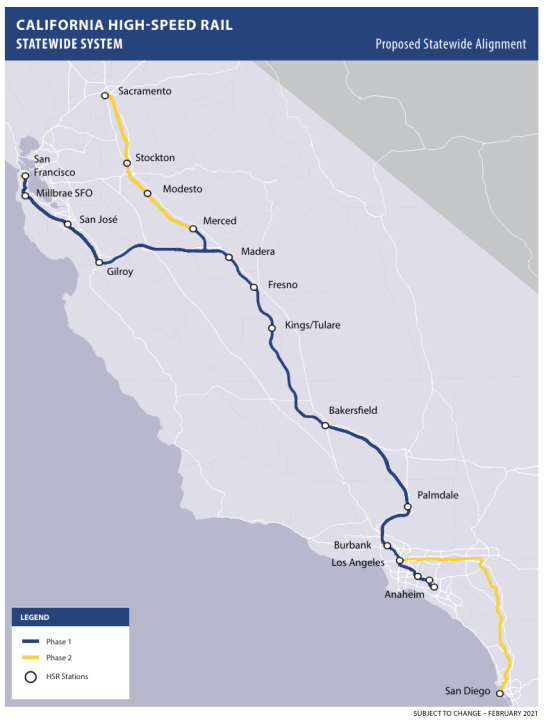Los Angeles will soon have high-speed rail. Could it eventually reach San Diego?

SAN DIEGO (FOX 5/KUSI) — Construction to California’s long-discussed high-speed rail network is finally making headway, with work beginning on Monday to get a privately-owned bullet train between Los Angeles and Las Vegas up and running.
The $12 billion Brightline West rail line across state lines complements an existing, ambitious state plan to connect major cities in California with an 800-mile, intrastate fast train system from San Francisco and Sacramento in the north to Los Angeles and San Diego in the south.
Although, the project, which was approved by voters in 2008, has been beset by ballooning costs and routing disputes. Now it could be decades before San Diegans see any high-speed rail service through the county.
Rail spikes hammered, bullet train being built from Sin City to the City of Angels
Jim Patrick, director of communications for the Southern California sector of the state’s High-Speed Rail Authority, told FOX5SanDiego.com on Tuesday that officials have “stopped actively working” on the proposed bullet train corridor between San Diego and Los Angeles to focus on the first phase of the system’s buildout, which is a San Francisco to Anaheim connection.
Once the line between San Francisco and Anaheim is substantially complete, Patrick said officials will revisit expanding the rail network with the its Phase 2 links: the San Diego line and a connection between Sacramento and Merced.
For San Diegans, the potential alignment drafted by officials in the early 2000s routes east of Los Angeles, dives south with the Interstate 15, and then cuts over state Route 56 to run along Interstate 5 up until the San Diego International Airport.
A map drafted in 2021 of the proposed alignment with the Phase 2 projects can be found below.
British Airways adds second daily flight to London from San Diego
However, plans for the San Diego line remain relatively unsettled. For one, Patrick says funding for the Phase 2 projects has not been secured: They are still working to get federal funding for the stretches in Phase 1 connecting Bakersfield to Los Angeles and San Jose to the Central Valley.
The final price tag for the first phase of the project is estimated to fall anywhere between $88.5 billion to $127.9 billion, according to Patrick — the majority of that coming from federal funding dedicated towards high-speed rail projects and infrastructure.
Outside of funding, Patrick says that state officials will likely need to redo much of the planning work that has already been done by the High-Speed Rail Authority, as it already about 15 years old and will become even more outdated by the time Phase 2 begins.
“We will more than likely start our process over in the San Diego area,” he said. “There will be public meetings. There will be opportunities for public agencies to provide comment and ask for the best possible high-speed rail service we can provide. And we will go through the environmental clearance process along the entire route.”
Patrick noted that the state is “moving along briskly” in getting the 171-mile run through Central Valley up and running, having put out orders for trains and tracks this year as the infrastructure groundwork wraps up between Merced and Bakersfield.
Tests of the fast trains along the Central Valley corridor are anticipated to begin in 2029, with fare service beginning sometime between 2030 to 2033 — a few years after Brightline West is hoping to have its high-speed rail line up and running.
MTS launches ramped-up security on buses, trolleys
According to Patrick, the section between San Francisco and San Jose is also already “largely complete” as the High-Speed Rail Authority did not need to build new tracks, opting to instead just electrify the existing rail lines between the two cities.
At this time, though, there is no official timeline for when the remaining segments included in Phase 1 will be complete, allowing the state to transition to the San Diego and Sacramento links.
“Completing Phase 1 depends on federal funding for high-speed rail,” Patrick said. “And until we see what kind of financial commitment the federal government is willing to make, we can’t make official timelines.”
When all is said and done, Patrick said California officials hope to be able to connect San Diego to Los Angeles with a bullet train that will also connect with the city’s light-rail and bus networks, cutting the trip down to about an hour and a half between the two metropolitan areas.
For the latest news, weather, sports, and streaming video, head to FOX 5 San Diego & KUSI News.


